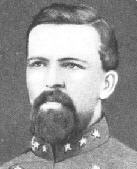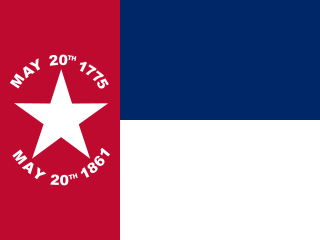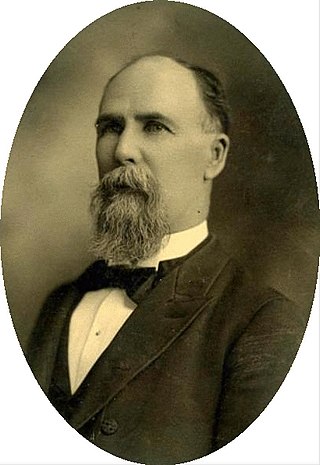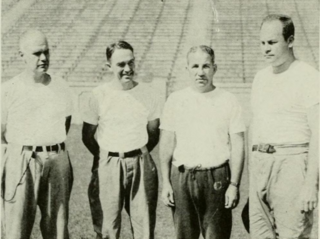
Scouting in North Carolina has a long history, from the 1910s to the present day, serving thousands of youth in programs that suit the environment in which they live.

Tar Heel is a town located in Bladen County, North Carolina, United States. As of the 2010 census, the town population was 117.

The Tar River is a river that is approximately 215 miles (346 km) long, in northeast North Carolina flowing generally southeast to an estuary of Pamlico Sound. The Tar River becomes the tidal Pamlico River once it underpasses the U.S. Highway 17 Bridge in Washington, North Carolina.

Ralph Campbell Jr. was an American politician and auditor who served as the North Carolina State Auditor from 1993 to 2005. A member of the Democratic Party, he was the first African American to hold statewide elected executive office in North Carolina. Campbell was born in Raleigh, North Carolina, and he attended St. Augustine's College. He graduated with a degree in business administration in 1968, and served in the United States Army Reserve from 1971 until 1977. After leaving the reserve, he worked various government jobs before being elected to the Raleigh City Council in 1985.

James Lowry Robinson was a Democratic politician from the U.S. state of North Carolina; he served as the fourth lieutenant governor of the state for four years under Governor Thomas J. Jarvis and as acting Governor of North Carolina for one month in 1883. Earlier in his political career he served in the North Carolina House of Representatives, including as Speaker, and then the North Carolina Senate.

Naval stores are all liquid products derived from conifers. These materials include rosin, tall oil, pine oil, and terpentine. Crude gum or oleoresin can be collected from the wounds of living pine trees.

Isaac Erwin Avery was a planter and an officer in the Confederate States Army. He died at the Battle of Gettysburg during the American Civil War. Avery is most remembered for a poignant blood-stained note that he wrote as he lay dying on the slopes of Cemetery Hill at Gettysburg.

During the American Civil War, North Carolina joined the Confederacy with some reluctance, mainly due to the presence of Unionist sentiment within the state. A popular vote in February, 1861 on the issue of secession was won by the unionists but not by a wide margin. This slight lean in favor of staying in the Union would shift towards the Confederacy in response to Abraham Lincoln's April 15 proclamation that requested 75,000 troops from all Union states, leading to North Carolina's secession. Similar to Arkansas, Tennessee, and Virginia, North Carolina wished to remain uninvolved in the likely war but felt forced to pick a side by the proclamation. Throughout the war, North Carolina widely remained a divided state. The population within the Appalachian Mountains in the western part of the state contained large pockets of Unionism. Even so, North Carolina would help contribute a significant amount of troops to the Confederacy, and channel many vital supplies through the major port of Wilmington, in defiance of the Union blockade.

The 26th North Carolina Infantry Regiment was an infantry regiment of the Confederate States Army during the American Civil War. The regiment was composed of ten companies that came from various counties across North Carolina and Virginia. It is famous for being the regiment with the largest number of casualties on either side during the war.

Thomas Fentress Toon was a brigadier general in the Confederate States Army during the American Civil War.

The following outline is provided as an overview of and topical guide to the U.S. state of North Carolina. Wikipedia:WikiProject North Carolina Category:Top-importance North Carolina articles are indicated.

The 4th North Carolina Infantry Regiment was a Confederate States Army regiment during the American Civil War, active from 1861 until the war's end in April 1865. Ordered to Virginia, the unit served in General Winfield S. Featherston’s, George B. Anderson’s, Stephen D. Ramseur’s, and William R. Cox’s Brigade. Its field officers were Colonels George B. Anderson, Bryan Grimes, Edwin A. Osborne, and James H. Wood; Lieutenant Colonels David M. Carter and John A. Young; and Majors Edward S. Marsh and Absalom K. Simonton. It was nicknamed "The Bloody Fourth" after the high rate of casualties at the Battle of Seven Pines.
The 1922 North Carolina Tar Heels football team represented the University of North Carolina in the 1922 college football season. Led by second year head coaches Bob Fetzer and Bill Fetzer, the team compiled a record of 9–1 and tied for the Southern Conference (SoCon) championship. The team's quarterback was Monk McDonald.
The 1925 North Carolina Tar Heels football team was an American football team that represented the University of North Carolina as a member of the Southern Conference during the 1925 season. North Carolina compiled a 7–1–1 record (4–0–1 against conference opponents, finished third in the conference, shut out six of nine opponents, and outscored all opponents by a total of 123 to 20. The team played its home games at Emerson Field in Chapel Hill, North Carolina.
The 1923 North Carolina Tar Heels football team represented the University of North Carolina during the 1924 college football season as a member of the Southern Conference (SoCon). The Tar Heels were led by head coaches Bob Fetzer and Bill Fetzer in their third season and finished with a record of five wins, three losses, and one tie.
The 1930 North Carolina Tar Heels football team was an American football team that represented the University of North Carolina as a member of the Southern Conference during the 1930 college football season. In their fifth season under head coach Chuck Collins, North Carolina compiled an 5–3–2 record.

The 1945 North Carolina Tar Heels football team represented the University of North Carolina at Chapel Hill during the 1945 college football season. The Tar Heels were led by third-year head coach Carl Snavely, his first at UNC since 1935. North Carolina played their home games at Kenan Memorial Stadium and competed as a member of the Southern Conference.
The 1942 North Carolina Tar Heels football team represented the University of North Carolina at Chapel Hill during the 1942 college football season. The Tar Heels were led by first-year head coach Jim Tatum and played their home games at Kenan Memorial Stadium. They competed as a member of the Southern Conference. Tatum left the school to join the Navy at the end of the season. He returned to coach the Tar Heels from 1956 to 1958.
The 1940 North Carolina Tar Heels football team represented the University of North Carolina at Chapel Hill during the 1940 college football season. The Tar Heels were led by fifth-year head coach Raymond Wolf and played their home games at Kenan Memorial Stadium. They competed as a member of the Southern Conference.
The 1931 North Carolina Tar Heels football team was an American football team that represented the University of North Carolina during the 1931 college football season as a member of the Southern Conference. In their sixth year under head coach Chuck Collins, the team compiled an overall record of 4–3–3, with a mark of 2–3–3 in conference play.














